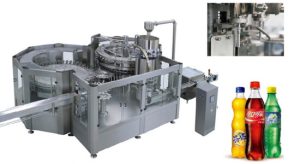Carbonated drinks are an essential part of the global beverage industry, offering a refreshing, fizzy experience that has captivated consumers for centuries. Whether it’s a classic soda, sparkling water, or a glass of chilled beer, the magic behind the bubbles is the process of carbonation. But how exactly are these fizzy beverages made? Let’s explore the journey of carbonation from start to finish, including the methods and equipment involved.
What is Carbonation?
At its core, carbonation is the process of dissolving carbon dioxide (CO2) gas into a liquid, creating the characteristic bubbles we associate with fizzy drinks. This happens when CO2 combines with water to form carbonic acid, which not only adds fizz but also imparts a slight tangy taste to the beverage.
Carbonated drinks include a variety of products, from sodas and sparkling waters to alcoholic beverages like beer and champagne. The technique used to carbonate these drinks can vary, depending on the type of beverage and production scale. Let’s dive into the different methods used to carbonate drinks.

The Two Main Methods of Carbonation
There are two primary methods of carbonation: forced carbonation and natural carbonation.
- Forced Carbonation
Forced carbonation is the most common method, especially for mass production. This process involves injecting CO2 into a liquid under high pressure, which allows the gas to dissolve into the beverage efficiently. The pressure helps the CO2 molecules enter the liquid, creating the familiar bubbles. This method is quick, controlled, and perfect for producing large volumes of carbonated drinks like sodas, sparkling waters, and ciders. - Natural Carbonation
Natural carbonation, on the other hand, relies on the fermentation process to produce CO2. This is commonly used for beverages like beer, kombucha, and champagne. During fermentation, yeast consumes sugars in the liquid and produces alcohol and CO2 as byproducts. The CO2 naturally carbonates the drink, although some products might still undergo forced carbonation to achieve the desired level of fizz.
The Carbonation Process: From Start to Finish
Now that we understand the methods, let’s break down the carbonation process step by step.
- Ingredient Preparation
Before carbonation can begin, the right ingredients need to be mixed. For sodas, this includes water, sweeteners (sugar or alternatives), flavors, and sometimes preservatives. For alcoholic beverages, the key ingredients are water, yeast, and sugars. The quality of the ingredients plays a crucial role in the final flavor and texture of the drink. - Carbonation
Once the ingredients are prepared, it’s time to carbonate the liquid. In forced carbonation, CO2 gas is pumped into the liquid under high pressure. This occurs in a sealed tank or container. For natural carbonation, the liquid is fermented in an airtight vessel, and the CO2 naturally infuses the drink as the yeast consumes the sugar. - Control the Pressure
During carbonation, pressure is key. The higher the pressure, the more CO2 can dissolve in the liquid. However, if the pressure is too high, the drink may become too fizzy, and the bubbles could overwhelm the flavor. In contrast, low pressure results in a flat drink. For optimal results, the pressure and temperature are carefully controlled to ensure the right balance of bubbles and flavor. - Post-Carbonation Treatment
After carbonation, the drink is typically chilled. Cold temperatures help retain the CO2 in the liquid, ensuring that the bubbles remain intact. Afterward, the drink is often filtered to remove any remaining yeast or impurities, especially in natural carbonation processes. - Bottling and Packaging
The final step is bottling or canning the drink. During this stage, the beverage is sealed in containers to preserve its carbonation. Bottles or cans are usually filled under pressure to keep the CO2 dissolved. In some cases, a small amount of CO2 is added just before sealing to ensure the drink retains its effervescence.
Equipment Used in Carbonating Drinks
The carbonation process requires specialized equipment to ensure consistency and quality. The main tools involved are:
- CO2 Tanks: These are used to store and supply CO2 gas. They come in various sizes, depending on the scale of production.
- Carbonation Stones: These are small, porous stones that help disperse CO2 gas evenly into the liquid, creating fine bubbles.
- Regulators: These devices control the pressure of CO2 being injected into the liquid.
- Carbonation Systems: Commercial carbonation systems, like the inline carbonation system, inject CO2 as the liquid flows through a pipe. This ensures the drink is carbonated evenly before bottling.

Natural vs. Forced Carbonation: Which is Better?
Both natural and forced carbonation have their advantages. Forced carbonation is faster and allows for greater control over the level of fizz, making it ideal for large-scale production. On the other hand, natural carbonation gives the beverage a more authentic, organic feel, often preferred for craft beers and artisanal drinks.
For manufacturers, the choice between natural and forced carbonation often depends on the type of beverage being produced, the desired level of fizz, and the production scale.
The Role of Technology in Carbonation
Advancements in carbonation technology have made the process more efficient and precise. Modern carbonation systems allow beverage makers to finely tune the level of CO2 in their drinks, ensuring consistency across every batch. Companies like DATONG specialize in providing high-end carbonation equipment that helps manufacturers maintain control over the carbonation process, delivering perfect results every time.
Conclusion: The Art of Carbonation
Making carbonated drinks involves more than just adding gas to a liquid. It’s a delicate balance of ingredients, pressure, temperature, and timing to create the perfect bubbly beverage. Whether you’re crafting a soda, beer, or sparkling water, the methods and equipment you choose will significantly impact the quality of your product.
As a manufacturer of carbonation equipment, DATONG is committed to providing the best solutions for beverage production. Our cutting-edge carbonation systems help ensure that your drinks are carbonated to perfection, every time. Reach out today to learn more about how our technology can improve your production process.
